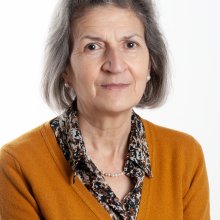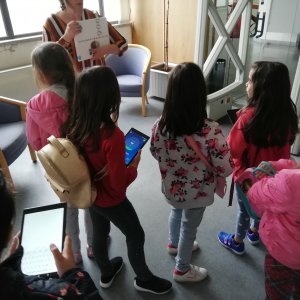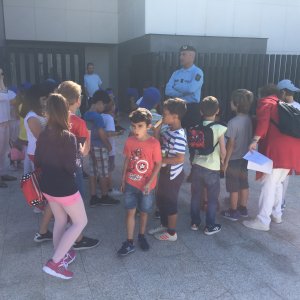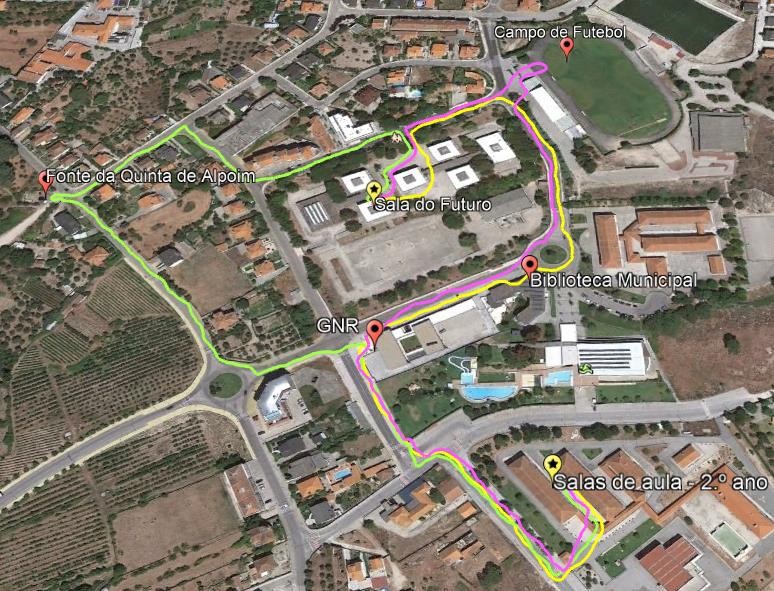
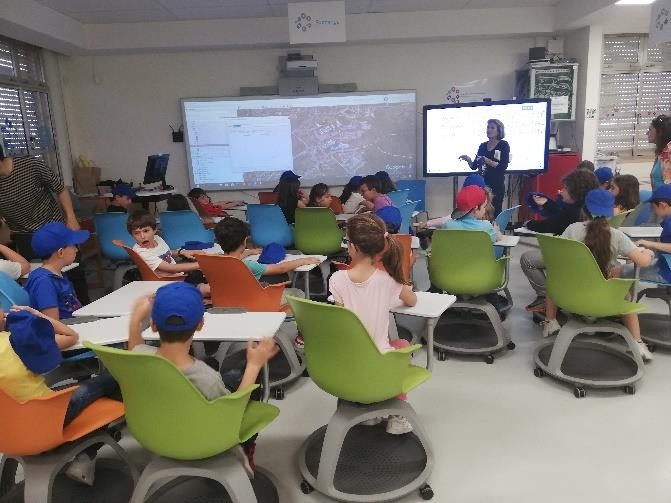
Routes – from our school to the future classroom
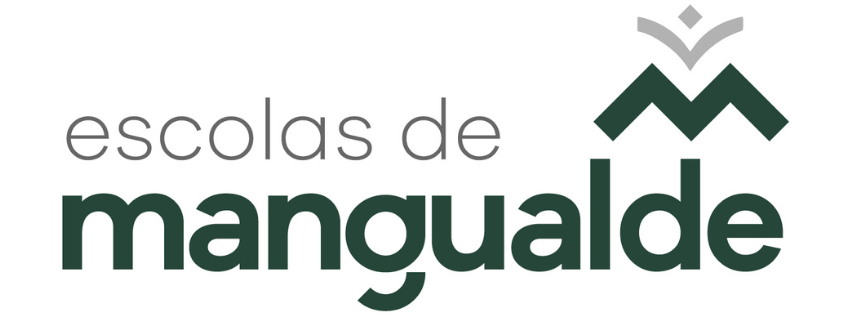
Activity description
In this outdoor activity, students analyze routes between their school and the main school of the group (Agrupamento). Along the way, at different points on the various routes — such as the GNR station, municipal library, football stadium, and Gomes Eanes de Azurara Basic School library — they are challenged to solve math problems involving measurements and multiplication and division operations.
Wheel odometer
Coffee cup to be used for solving the problem at the “Fonte da Quinta do Alpoim” point
9 tablets, one per group, with all necessary materials (Playstore app “Pedometer”; Google Earth Pro; Google Keep; KMZ file; Google Forms with math problems)
Prepare the Google Earth KMZ file
Organize the students’ snack for the day of the activity
Invite support teachers to accompany a group of students on one of the route itineraries
Schedule the intervention with the GNR Safe School team at the stopping point
Ensure that 20 books and 4 empty shelves are available at the municipal library to carry out the defined math problem
Ensure that the football stadium will be open for students to complete the math activity
Student profiles
Essential learnings
Please download the following files:
Activity guides
Activity Introduction
Students are asked about possible routes within the Ana de Castro Osório (ACO) school. For example:
-
How do we go from the classroom (starting point) to the cafeteria (end point)? And to the soccer field?
-
What places do we pass by from the starting point to the end point? Give examples.
-
If you had to explain to a classmate the route taken, how would you do it? What reference points could you give?
Activity Development
In the classroom, the KMZ file is projected on Google Earth, and the 3 routes that the students must follow are analyzed. Students are asked about:
-
The shortest route
-
Their estimates of the distances covered on each route
-
Points identified on the map
-
Alternatives to move from the classroom to the “sala do futuro” (future room)

Detailed routes to be followed in groups, specifying the specific waypoints for each of the 3 routes by color:
-
Green: GNR – Fonte da Quinta de Alpoim – Sala do Futuro
-
Yellow: GNR – Municipal Library – Sala do Futuro
-
Pink: GNR – Football Field – Sala do Futuro
The class is then evenly divided into 3 groups, each assigned one route. Each group is accompanied by a teacher during the walk. Each group uses different measuring instruments to calculate the distances of their routes:
-
Group 1: Pedometer (app on tablet)
-
Group 2: Wheel odometer
-
Group 3: Built-in GPS on tablet
Additionally, each group has 3 tablets with:
-
Google Forms containing three math problems
-
Google Keep for recording photos
-
Google Earth with the kmz file
Students take photos during their routes using Google Keep (for example, at the GNR post) and write a brief description explaining what building it is and its purpose. Along the way, groups identify street names and photograph them with Google Keep. This will be used to present the route to the other groups.
All 3 groups start the routes together in the classroom, following a common path to the first stop at the GNR post. There, members of the “Escola Segura” (Safe School) team give a short intervention related to public road safety and other topics they define. The officers interact informally with the students as they pass by (lasting no more than 5 minutes). After this stop, the groups follow their assigned routes.
On each route, there is a point where students must solve a math problem involving multiplication, division, and measurements, presented in the “student guide” for each destination:
-
Fonte da Quinta de Alpoim
-
Municipal Library
-
Football Field
For the math problem at the football field, students measure different “lines,” such as the length (in meters) of the penalty area, goal area, or midfield line. When discussing the problem later in the large group in the Sala do Futuro, the concept of perimeter can be introduced.
At the municipal library, students have 20 books to organize on 4 shelves. They can explore division problems in various ways (e.g., 15 books on 3 shelves). It is important to relate the books and shelves to fractional numbers: ¼, ⅓, etc. Besides the math problem, students borrow a book related to Mangualde, take photos of relevant pages (e.g., important dates, notable figures, monuments), and return the book to the library by the end of the day or another agreed time.
At Fonte da Quinta de Alpoim, a coffee cup is used to work on multiplication. Students are asked if anyone is thirsty after the walk, and one student drinks 6 cups of water. Depending on the group size, they explore how many cups 2, 3, or more students drink if each drinks 6 cups, practicing the multiplication table of 6.
All three routes end at the Sala do Futuro, where conclusions are discussed and math problems are explored. Each group chooses a spokesperson to present their route to classmates, covering:
-
Starting point
-
Streets passed
-
At least two landmarks
-
Distance traveled based on the three measuring tools used
They should use the Google Earth Pro application on the classroom computer to confirm whether the distance traveled matches the marked distance, by following these steps:
-
Right-click on each “path” (line or route) and then click on “Properties,” as shown in the following figure:
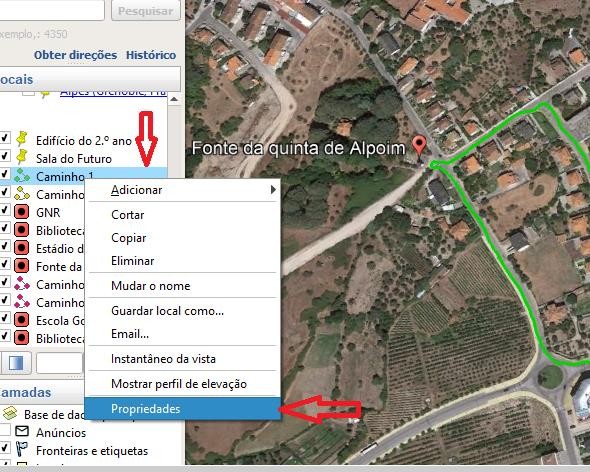
2. Click on the “Measurements” tab, selecting the unit “Meters.”
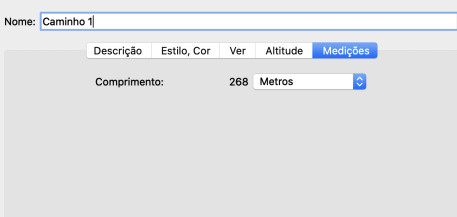
Conclusion of the Activity
In the “Sala do Futuro” (Future Room), students present the math problems they worked on and share their individual problem-solving strategies.
There is also a discussion about some characteristics of the different routes:
-
Which route was the shortest?
-
Could there be an alternative to these three routes, given the same start and end points (the students’ classroom building and the Future Room)? If yes, how could such a route be created using Google Earth?
Extension Activities
-
Add the photos taken to the Google Earth Pro map.
-
Explore Google Earth Pro to view other points on the map and, for example, discuss a route starting from Mangualde and ending in Lisbon.
Essential learnings
Evidence / Student action
- Elaborar itinerários do quotidiano, em plantas simplificadas do seu meio, assinalando diferentes elementos naturais e humanos.
- Elaborar itinerários com recurso ao Google Earth – conclusão da atividade.
- Descrever elementos naturais e humanos do lugar onde vive através da recolha de informação em várias fontes documentais.
- Apresentação, em grande grupo, do itinerário percorrido, identificando nomes de ruas, locais de referência.
- Medir comprimentos, áreas, [...].
- Reconhecer e memorizar factos básicos da multiplicação e da divisão.
- Confirmação de medidas com recurso ao Google Earth; problema 1 de matemática (Guião do Aluno).
- Conceber e aplicar estratégias na resolução de problemas envolvendo grandezas e propriedades das figuras geométricas no plano e no espaço, em contextos matemáticos e não matemáticos, e avaliar a plausibilidade dos resultados.
- Problemas de matemática – ver guião do aluno.
HypatiaMat. (s.d.). Itinerários. Acedido a 12 de fevereiro de 2019 em https://hypatiamat.com/itinerariosSubPage.php
Problem 1 - How long is the penalty area line on the Mangualde football field?
Observe the lines that make up the playing field at the football stadium. How many meters long is the penalty area line if you start measuring from a certain corner, follow the other three corners continuously, and end at the starting corner? (Use the odometer to measure the penalty area line.)

Problem 2 – Distributing Books on Thematic Shelves in the Municipal Library
Now that you have arrived at the library, you have a problem to solve! Arrange the 20 books on the 4 shelves that the librarian will indicate. You need to arrange them evenly: each shelf must have the same number of books.
Explain how you arrived at the result.
Problem 3 – Liters of Water
Now that you have completed half of the route, you can take a break and drink some water! You have to drink exactly 6 small cups of water. If two students drink water, how many cups do both students drink in total? And 3 students? And 4…?
